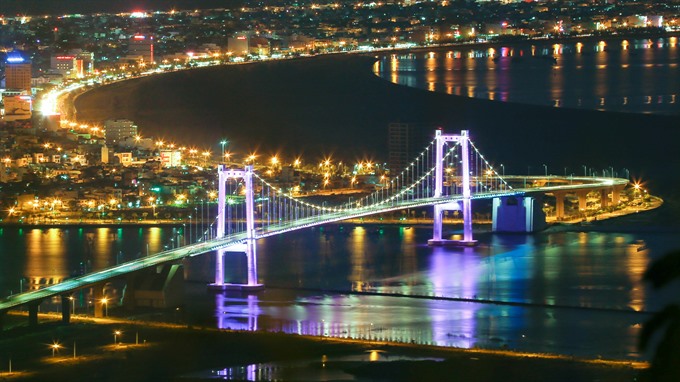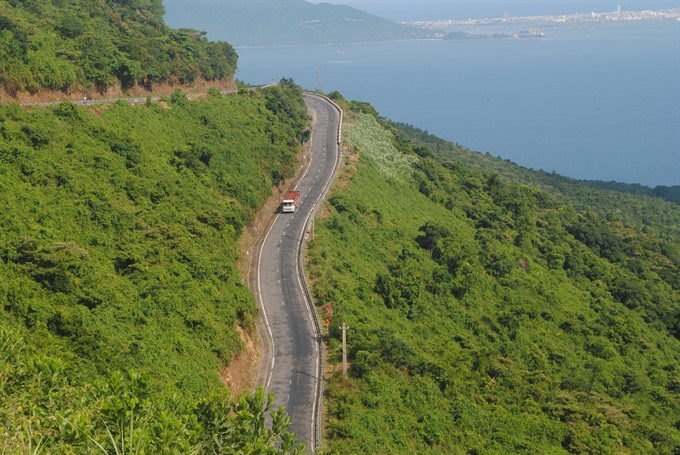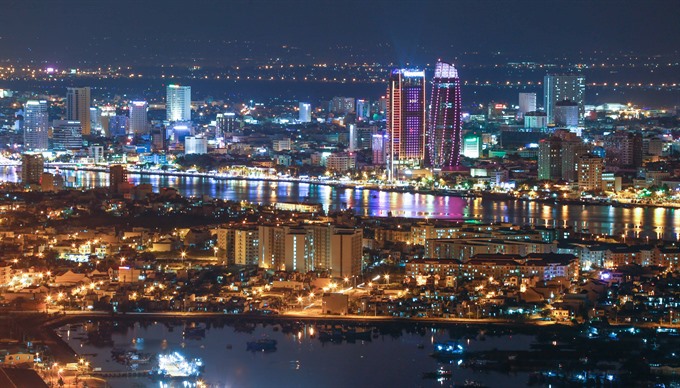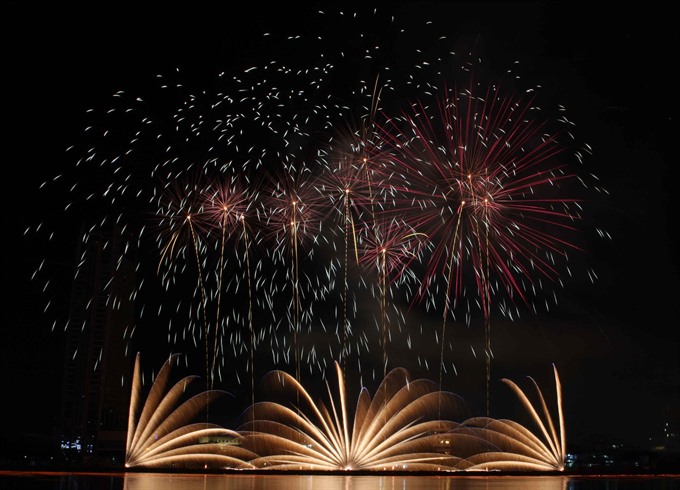An Asia-Pacific pearl glows in Viet Nam
Da Nang has taken full advantage of being able to start afresh, unencumbered for the most part by outdated infrastructure, to become the most livable place in the country.
 |
| Glittering in the dark: The Thuan Phuoc Bridge over the Han River. VNS Photo Tran Le Lam |
Da Nang is used to getting a major makeover, every 150 or 250 years or so.
Quang Nam-Da Nang was founded in 1471 during the reign of King Le Thanh Tong on an area stretching to today’s Phú Yên Province.
It was re-established in 1832 by King Minh Mạng under the Nguyen Dynasty.
In its latest makeover, 20 years ago, Da Nang was separated from Quang Nam Province, and came under the direct management of the national government, making up a Fab Five along with Ha Noi, Ho Chi Minh City, Hai Phong and Can Tho.
Perhaps it is in its latest incarnation that Da Nang has seen the ‘ultimate’ transformation, amazing even elderly citizens who’ve witnessed the transformation live, on a ring-side seat.
“It’s unbelievable! I would not be able to recognise the old streets if I did not visit them often. The banks of the Han River changed almost completely when it created more spaces for pedestrians and more cruise ship passengers in the river every night,” said Nguyen Van Anh, 77, a senior resident.
“Bach Dang Street was my rendezvous after work for more than 40 years. It did not have many good cafés or bars, but it is a new recreational centre for locals and tourists.
“The Han River is lit up now, with colourful decorations and designs shining from bridges and recreational spots. We can now relax with several activities on the river banks in peace.”
 |
| Getting there: A view of the Hai Van Pass in Da Nang City. — VNS Photo Cong Thanh |
The septuagenarian recalled that Bach Dang Street and the Han River were poorly lit 20 years ago and slums covered the other side of the river. A ferry from the Son Tra Peninsula carried workers, vendors and fishermen to the city’s downtown area every morning and evening.
The peninsula, or Son Tra District, was connected to downtown Da Nang with just 2 bridges. The beach district was home to poor fishermen and low income labourers for a long time, while the rich, civil servants and businesspeople, gathered in the city’s centre. Today, the peninsula is a favourite eco-tourism destination with resorts, hotels and beach property projects.
Anh, who was born and brought up in a Da Nang suburb, said that his native village, Khue Trung, became Nui Thanh Street – a major road in the city now.
The city was known as Tourane during the French colonial rule and its centre was the Bach Dang Street area along the Han River.
The old building on Bach Dang Street – now housing the city’s People’s Council – was the only one that had been preserved since it was built over 100 years ago, Anh said.
Quick facelift
Several impressive infrastructural works are responsible for giving the seaside city a quick facelift, turning it into a major tourist attraction with extraordinary architecture and decorations.
9 bridges were built to connect the city’s downtown and the Son Tra Peninsula – home to pristine white sand beaches and a vast area of forests and mountains.
Each bridge spanning the Han River, featuring typical symbol of the city’s seas, rivers and mountains, has become an attraction by itself, adding their total charm to river cruises.
 |
| Shining city: Night scenery of the Han River in Da Nang. VNS Photo Tran Le Lam |
The city’s downtown and shopping centres, a small area with a few main streets 20 years ago, is now 4 times as large.
When it separated from its parent province, Da Nang had just 360 streets. Now it has more than 2,000.
Son Tra, the longest stretch of land heading to the sea in the country, has also been part of the major growth that has changed its landscape and living standards.
Thousands of slums on the east side of the Han River were cleared to create community and entertainment spaces, while homeless fishermen were resettled in apartments.
A vast pristine beach where fishing boats came ashore every night, was done up to attract tourists. The number of beach resorts and hotels has increased from 61 to nearly 600 in 20 years, and the city can now host 5.6 million tourists – 27 times as many as it could in 1997.
The trailblazer
Pham Van Hang, a stone sculptor, recalled that the city’s growth came out of “endless endeavours” by its leadership, and the reform was masterminded by the late Party Committee Secretary Nguyen Ba Thanh.
Thanh, who died of cancer in 2015, was a trailblazer of the reform process, when he pushed for separation from Quang Nam-Da Nang, sculptor Hang said.
He recalled that Thanh had asked former Prime Minister Vo Van Kiet to recognise Da Nang as a centrally-governed city to boost its development.
sculptor Hang said Thanh had complained that Hai Phong, a twin city with Da Nang, had received a huge support from the national government, while Da Nang did not.
So 1997 was a landmark year, when the national government decided Da Nang would be the 5th a centrally-governed city after Ha Noi, HCM City, Can Tho and Hai Phong.
“It was the desire of the city’s leaders and residents, Da Nang and Quang Nam, like an adult wearing a small shirt, had to change to grow. The two localities had a huge potential for development, but it needed a mechanism and a larger runway for taking off,” said the city’s incumbent Party Committee Secretary, Nguyen Xuan Anh.
Secretary Anh said the separation was a driving force for Da Nang to speed up development of its traffic and urban infrastructure from a 3rd class city under provincial management into a 1st class city within 20 years.
“Da Nang has also been seen as a forerunner amongst Vietnamese cities in developing social welfare and security policies. We do our very best to earn the city the most liveable status in Viet Nam and make it a world class urban area,” the city leader said.
 |
| Spectacle: One of the main cultural events in Da Nang is an annual international fireworks competition. — VNS Photo Cong Thanh |
Da Nang was the first locality in Viet Nam to implement the '5 No's, 3 Yes's ' programme. The city authorities have made their great efforts to reach the targets of no starving households, no illiterate people, no itinerant beggars, no drug-addicts in the community, and no murders for property in the city. In addition, they have aimed to ensure that all local residents have their own houses, a stable job and a cultural lifestyle.
Over 3,300 apartments have been built over the 2008-2015 period, providing enough accommodation for local residents, while 34,000 jobs were created, bringing unemployment rate down to 4.9%.
Secretary Anh, 41, who is also Chairman of the city’s People’s Council, said Da Nang earned total revenues of 54 trillion VND (US$2.4 billion) in 2016, contributing 19 trillion VND ($840 million) to the State budget.
“The city has seen rapid development in tourism and services, from 61 hotels with more than 2,000 rooms in 1997 to 585 hotels with 21,000 rooms after 20 years,” Mr Anh said. “Da Nang is now 4 times larger than in 1997, with a total area of 21,300ha."
Vice Chairman of the city’s People’s Committee Dang Viet Dung said Da Nang has come out top of Viet Nam’s Provincial Competitiveness Index (PCI) for 2015, the third consecutive year that the city has topped this ranking. In addition, the city had been a leader in administrative reform and application of information technology.
“Da Nang had reserved property for developers in seeking funds for infrastructure projects. We positively raised funds through our preferential policies…,” Vice Chairman Dung said.
| At home: Da Nang has chosen the red-shanked douc langur (Pygathryx nemaeus) as its official mascot for the 2017 APEC (Asia-Pacific Economic Co-operation) Summit.— VNS Photo Cong Thanh |
He added that the city had attracted total investment capital of US$11.4 billion in the 1997-2016 period, accounting for 2.4% of the national figure.
“We boosted administrative reforms to create smooth conditions for investors with long term interest in the city. We encouraged investment in the high-tech, logistics, tourism, services, ‘green’ and renewable industry sectors in building the city as a world brand tourism site by 2037,” Vice Chairman Dung said.
Mr Dung said the city’s economic restructuring had resulted in industry and services accounting for 97%, and agriculture for just 2%.
He said the city also managed a stable annual growth of 10.47% in the 1997-2015 period.
Unique smart city
At a meeting to mark the 20th anniversary of Da Nang’s recognition as centrally-governed city, Prime Minister Nguyen Xuan Phuc said the city should develop as a unique smart city and become a competitive global centre for tourism and services,
“Da Nang should serve as magnet for foreign direct investment, information technology and skilled workers. It should be a frontrunner in business reform, education and business start-ups,” he said, adding that the city should have 45,000 enterprises by 2020.
The Prime Minister also said that Da Nang, must build links with other central localities, and serve as the core of socio-economic development for the region. The city should improve the quality of its business environment in order to compete with other urban centres in the world.
He noted that 2017 would present the city of one million people with a great opportunity, as well as a challenge, when it hosts the APEC Economic Leaders' Week in November.
The city’s urban master urban plan for 2030 - 2050 also focuses on tourism as a core economic sector with special concentration on high-tech industry and hi-tech farms as well as organic and safe food farming.
As planned, the city will have a population of 2.3 million by 2030 with total area on 128,543ha.
The World Bank has been a major funds provider for Da Nang, agreeing to finance its 2013-2018 Sustainable Development Project with $202.4 million, after funding 70% of the city’s priority infrastructure project with an investment of $218.4 million in the 2008-2013 period.
Added visions
Tran Du Lich, head of the Consultative Group for Development of the Central Coastal Region, said Da Nang should attract high-end global tourists wanting premium services.
Lich feels that a lack of quality human resources has held back the city’s development.
Salvador Perez Arroyo, chairman of a major design consultancy firm, suggested that in order to acquire a respected, global image, Da Nang must be designed as a mega city that houses outstanding, significant structures like an opera house, museum and modern international airport.
"It needs to reserve a huge amount of space so it can integrate urban areas with the surrounding environment in a practical but ecologically aware manner," Arroyo said.
Peter Dyder, general manager of Indochina Capital, said the city should host more international-standard tourist attractions and events, like the Iron-Man Triathlon or the Da Nang Formula One racing weekend.
| Beached: Coracles line a beach on the Son Tra Peninsula in Da Nang City. — VNS Photo Cong Thanh |
Most livable city
The Asia institute of City Management (AiCM), which had commissioned a year-long study on Da Nang, has said that the coastal city is the most liveable place in Viet Nam.
The institute had commissioned the study to understand the development challenges the city faces.
Unlike the larger metropolises of Ha Noi and Ho Chi Minh City, which have much older infrastructure, Da Nang has had the advantage of starting afresh, it said.
“There is a constant challenge in being able to achieve a balance of both. Da Nang is one of the fastest-growing cities in Viet Nam, and was identified in our 2004 assessment of innovative city leaders in Asia.”
(Source: VNS/ DA NANG Today)